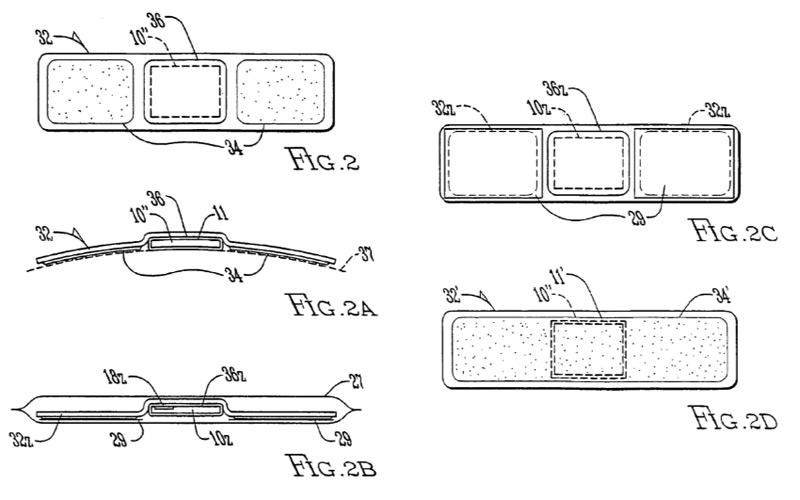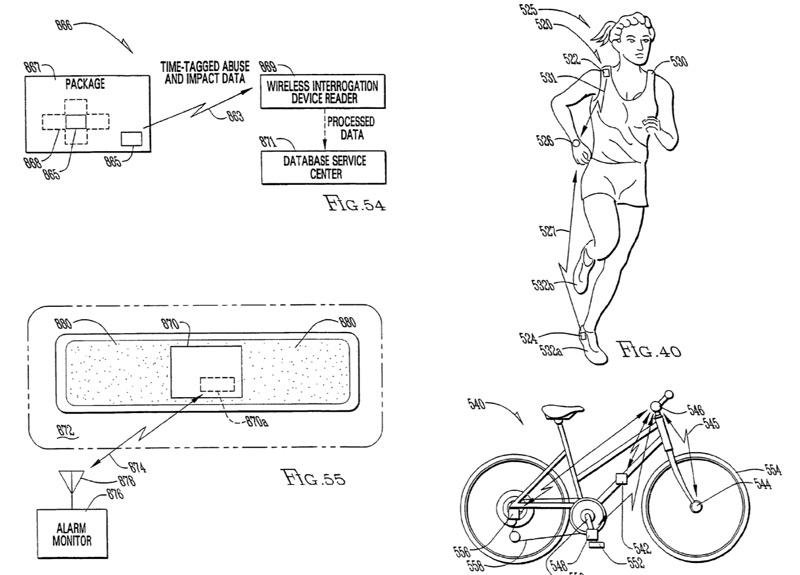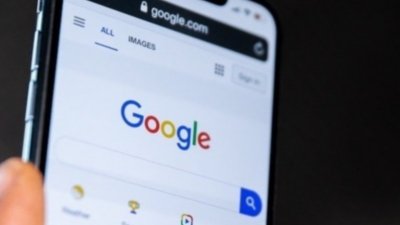The patent spans some 83 pages, and as such AppleInsider will quote or paraphrase generously from the filing, which incorporates several provisional patent applications.
Cause for Action
Apple begins early in the filing by stating its cause, noting that "the movement of objects and persons occurs continuously but [are] hardly quantified. Rather, typically only the result of [a] movement is known," such as object X moving from point A to point B, or person Y having run to the store. That said, the company notes that recent advances in technology have provided some quantification of movement, such as GPS products that now assist in determining the location of golf carts, vehicles and people.
"However, the detail of movement, minute to minute, second to second, is still not generally determinable," the electronics maker argues. "For example, the movement of tangible objects typically involves (a) the shipment or carrying of goods and (b) electromechanical or motorized apparatus (e.g., planes, trains, automobiles, robots). The exact movements of such objects, and the conditions that they are subjected to, from point to point, are only qualitatively known."
For instance, Apple notes that "a package is moved from location to location through delivery services like Federal Express or UPS; however what occurred during transportation, and what transpired to the package, is anyone's guess. Occasionally, an object within the package is broken, indicating that the package experienced excessive abuse; but whose fault it is, or how or when it happened, are not known. What environments the package experienced is also not readily known."
"The movement of persons, on the other hand, typically involves human-powered transportation, facilitated by biking, a wheelchair, or a motorized vehicle [such as] a car," the company continues. "Body movement involved in transportation is subjected to many forces, some of which are dangerous. But the prior art does not provide for this knowledge; there is no effective way, currently, to efficiently quantify human movement. In sports, physical fitness, and training, precise information about movement would assist in many ways. By way of example, how effective a hand strike is in karate or boxing is, today, only qualitatively known. Quantitative feedback would be beneficial."
Accordingly, one feature of Apple's patent is "to provide systems and methods addressing the afore-mentioned difficulties. A further feature of the invention is to provide methods and devices to quantify movement in a number of applications. Another feature of the invention is to monitor and report meaningful environment information such as temperature and humidity."
Movement Monitoring Devices
A couple of wireless monitoring devices are critical to Apple's concept, the first of which is called a movement monitor device, or "MMD." These tiny transmitters can take the form of an adhesive strip similar to a bandage and include a processor, a detector, communications port, and battery. Alternatively, Apple says they could assume the form of a credit card and/or include a magnetic element for adhering to metal objects. In any of the cases, they'd ideally also include a real time clock so that the transmitter can tag "events" with time and date information.
These MMDs would typically be interrogated by an interrogation device ("ID") or communicate to a remote receiver ("RR") over secure communications protocols. Their functions include detecting movement "metrics," including airtime, speed, power, impact, drop distance, jarring and spin. As Apple explains in more detail:
"In one aspect, the MMD continuously relays a movement metric by continuous transmission of data from the detector to a RR. In this way, a MMD attached to a person may beneficially track movement, in real time, of that person by recombination of the movement metrics at a remote computer. In one aspect, multiple MMDs attached to a person quantify movement of a plurality of body parts or movements, for example to assist in athletic training (e.g., for boxing or karate).
"In another aspect, multiple MMDs attached to an object quantify movement of a plurality of object parts or movements, for example to monitor or assess different components or sensitive parts of an object. For example, multiple MMDs can be attached to an expensive medical device to monitor various critical components during shipment; when the device arrives at the customer, these MMDs are interrogated to determine whether any of the critical components experienced undesirable conditions— e.g., a high impact or temperature or humidity."
MMDs could also be capable of measuring temperature, humidity, moisture, altitude and pressure. These environmental metrics would be combined into an MMD with a detector that facilitates the monitoring of movement metrics. "For temperature, the detector of one aspect is a temperature sensor such as a thermocouple or thermister. For altitude, the detector of one aspect is an altimeter. For pressure, the detector of one aspect is a pressure sensor such as a surface mount semiconductor element made by SENSYM."
MMDs could be collated and packaged in a single container, preferably similar to the cans or boxes containing adhesive bandages, Apple says. "Preferably, in another aspect, MMDs of the invention are similarly programmed within the container. By way of example, one container carries 100 MMDs that each respond to an event of "10 g's." In another example, another container carries 200 MMDs that respond to an event of "100 g's." Packages of MMDs can be in any suitable number N greater than or equal to two; typically however MMDs are packaged together in groups of 50, 100, 150, 200, 250, 500 or 1000. A variety pack of MMDs are also provided, in another aspect, for example containing ten 5 g MMDs, ten 10 g MMDs, ten 15 g MMDs, ten 20 g MMDs, ten 25 g MMDs, ten 30 g MMDs, ten 35 g MMDs, ten 40 g MMDs, ten 45 g MMDs, and ten 50 g MMDs. Another variety package can for example include groups of MMDs spaced at 1 g or 10 g intervals."
Any of these MMDs "can practically attach to almost anything to obtain movement information," the filing continues. "By way of example, a MMD of the invention can attach to furniture to monitor shipping of furniture. If the furniture were dropped, an impact event occurs and is recorded within the MMD, or transmitted wirelessly, with an associated time tag. When the furniture is damaged prior to delivery, a reader (e.g., an ID) reads the MMD to determine when the damage occurred— leading to the responsible party who may then have to pay for the damage. In a further example, if furniture is rated to "10 g's", a MMD (programmed and enabled to detect 10 g events) is attached to the furniture when leaving the factory, so that any 10 g event before delivery is recorded and time-stamped, again leading to a responsible party. Similarly, in other aspects, devices of the invention are attached to packages (e.g., FedEx or UPS shipments) to monitor handling. By way of example, fragile objects may be rated to 5 g; and an appropriately programmed MMD of the invention is attached to the shipment to record and time-tag 5 g events. In another aspect, fragile objects that should be maintained at a particular orientation (i.e., packages shipped within "This Side Up" instructions) are monitored by a MMD detecting inversions of about 180 degrees, such as through a Hall Effect detector.
"In one aspect, the MMD includes a tamper proof detector that ensures the MMD is not removed or tampered with once applied to an object or person, until an authorized person removes the MMD. In one aspect, the tamper proof detector is a piezoelectric strip coupled into or with the adhesive strip. Once the MMD is powered and applied to an object or person, a quiescent period ensues and the MMD continually monitors the tamper proof detector (in addition to the event detector) to record tampering activity. In the case of the piezoelectric strip, removal of the MMD from a person or object after the quiescent period provides a relatively large voltage spike, indicating removal. That spike is recorded and time stamped. If there are more than one such records (i.e., one record represents the final removal), then tampering may have occurred. Since date and time are tagged with the event data, the tamper time is determined, leading to identify the tampering person (i.e., the person responsible for the object when the tamper time was tagged)."
Apple notes that the ID can take the form of a cell phone. "Nearly one in three Americans use a cell phone. According to the teachings of the invention, data movement "metrics" are read from a MMD through the cell phone. Preferably, data communicated from the MMD to the cell phone is made only through secure communications protocols so that only authorized cell phones can access the MMD. In one specific aspect, MMD events are communicated to a cell phone or cellular network, and from that point are relayed to persons or additional computer networks for use at a remote location.
"Miniature tension or compression load cells are used in certain aspects of the invention. By way of example, a MMD incorporating such cells are used in measuring and monitoring tension and/or compression between about fifty grams and 1000 lbs, depending upon the application. In one aspect, the MMD generates a warning signal when the load cell exceeds a preselected threshold.
"There are thus several applications of the invention, including the monitoring of movement for people, patients, packages, athletes, competitors, shipments, furniture, athletes in training (e.g., karate), and industrial robotics. The benefits derived by such monitoring can be used by insurance companies and manufacturers, which, for example, insure shipments and packages for safe delivery to purchasers. Media broadcasters, including Internet content providers, can also benefit by augmenting information associated with a sporting event (e.g., airtime of a snowboarder communicated in real time to the Internet, impact of a football or soccer ball during a game, boxing glove strike force during a fight, tennis racquet strike force during a match). The MMD of the invention is small, and may be attached to practically any object— so ease of use is clearly another advantage. By way of example, an MMD can be mounted to the helmet or body armor of each football player or motocross competitor to monitor movement and jerk of the athlete. In such applications, data from the MMD preferably transmits event data in real time to a RR in the form of a network, so that MMD data associated with each competitor is available for broadcast to a scoreboard, TV or the Internet. Other advantages should be apparent in the description within."
Event Monitoring Devices
The second kind wireless monitoring device Apple describes in its filing is called an Event Monitoring Device, or "EMD," which can be used to monitor and report temperature, humidity, chemicals, heart rate, pulse, pressure, stress, weight, environmental factors and hazardous conditions. Nearly identical in structure, composition, and operation to MMDs, EMDs monitor one or more metrics for "events," where data is acquired that exceeds some predetermined threshold or value.
"By way of example, in one aspect the detector is a temperature sensor and the processor coupled to the temperature sensor seeks to determine temperature events that exceed a threshold," the filing says. "In another aspect, a humidity sensor is used as the detector and this sensor is monitored for a humidity event (e.g., did the EMD experience 98% humidity conditions). In another example, the detector and processor collectively monitor stress events, where for example it is determined that the EMD attached to a human senses increased heart rate of over 180 beats per minute (an exemplary "event" threshold). In still another aspect, the detector is a chemical (or pH) detector and the processor and detector collectively determine a change of chemical composition of an object connected with the EMD over some preselected time period.
"In one aspect, a plurality of EMDs are collated and packaged in a single container, preferably similar to the cans or boxes containing adhesive bandages. Preferably, in another aspect, EMDs of the invention are similarly programmed within the container. By way of example, one container carries 100 EMDs that each respond to an event of "5 degrees" variation from some reference temperature. In another example, another container carries 200 EMDs that respond to an event of "90 degrees" change absolute. Temperature sensors may be programmed to determine actual temperatures, e.g., 65 degrees, or changes in temperature from some reference point, e.g., 10 degrees from reference.
Packages of EMDs can be in any suitable number N greater than or equal to two; typically however EMDs are packaged together in groups of 50, 100, 150, 200, 250, 500 or 1000."
Apple goes on in the filing to describe how MMDs and EMDs can monitor and enhance activities and live broadcasts of Nascar races, marathons, rodeos, bike races, and extreme sports. They could also be applied to body armor and used for weight monitoring. Readers can check out the full 83-page patent here.
 Sam Oliver
Sam Oliver











-m.jpg)






 Christine McKee
Christine McKee
 Malcolm Owen
Malcolm Owen

 Sponsored Content
Sponsored Content

 Amber Neely
Amber Neely










37 Comments
I just hope Apple has something similar to Natal up it's sleeve.
If they can provide a NikePlus-ish solution for cycling they'd sell a million of them. PowerTap and things like Garmin Edge are pretty pricey solutions. If you could do output and location with an iPod/iPhone they'd have an edge over everything else.
As for the horseback example, tracking trail rides is problematic - often too much cover for GPS to work well and if they could track body motion for riding form... they'd have another winner.
I just hope Apple has something similar to Natal up it's sleeve.
That
would be really interesting and exciting.
Watching the demo of that - sure content etc was a little lame, but it's early days - the potential is fascinating!
As computing power reaches a point where it's almost as fast as i require - my MBP does just about everything in real time that i need, rendering is nearly a thing of the past - we will see new forms and content and this excites me.
Some day, battery technology will catch up (let alone keep pace) with all these exciting possibilities....... \
Some day, battery technology will catch up (let alone keep pace) with all these exciting possibilities....... \
Nokia just said they have created a phone that charges using the radio waves transmitted in the air by everything!! The power is really small but it is good start. Furthermore, I've read somewhere that some university invented a way to recharge batteries in few seconds!
I think we are getting there. Slowly but we are getting there.